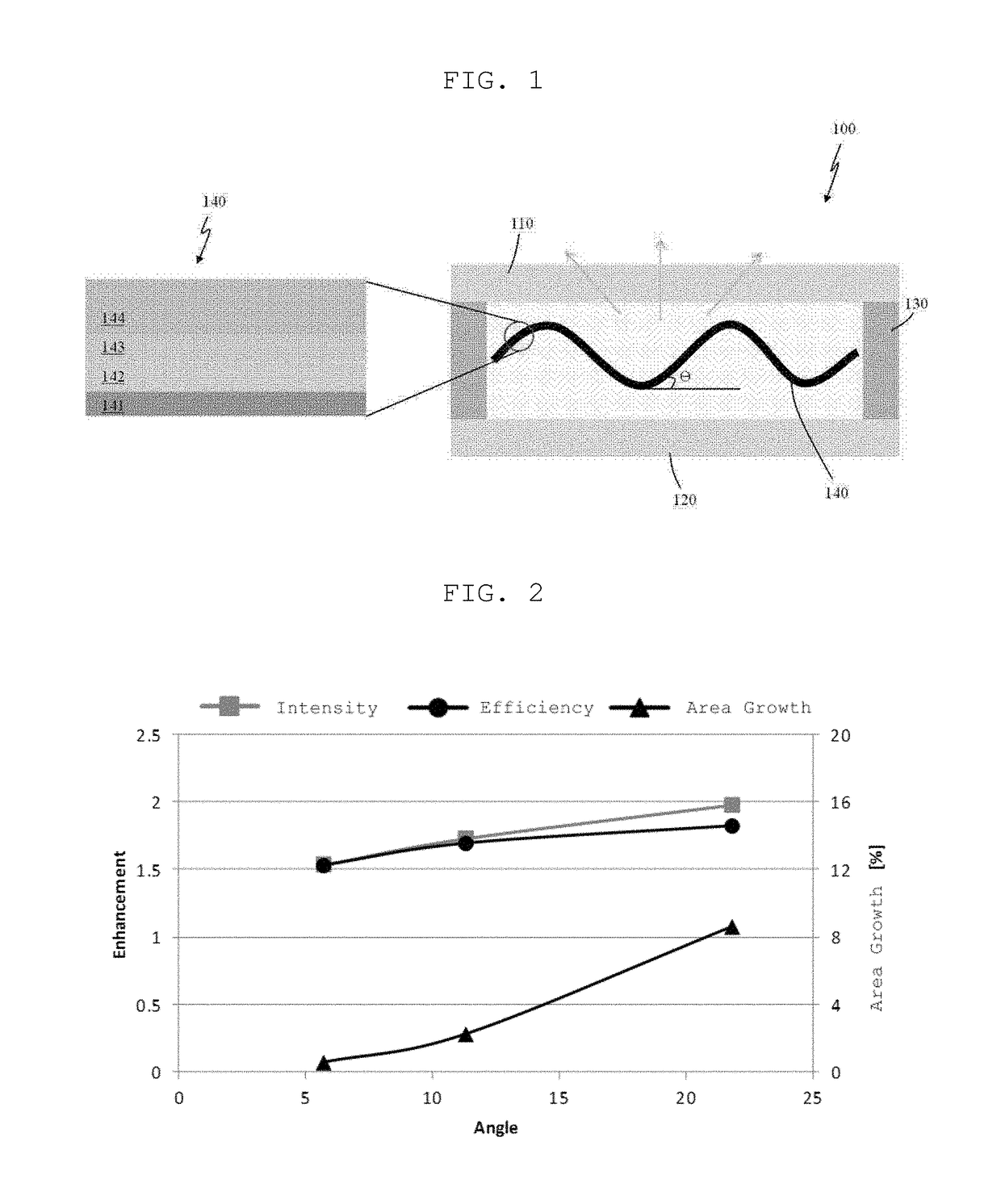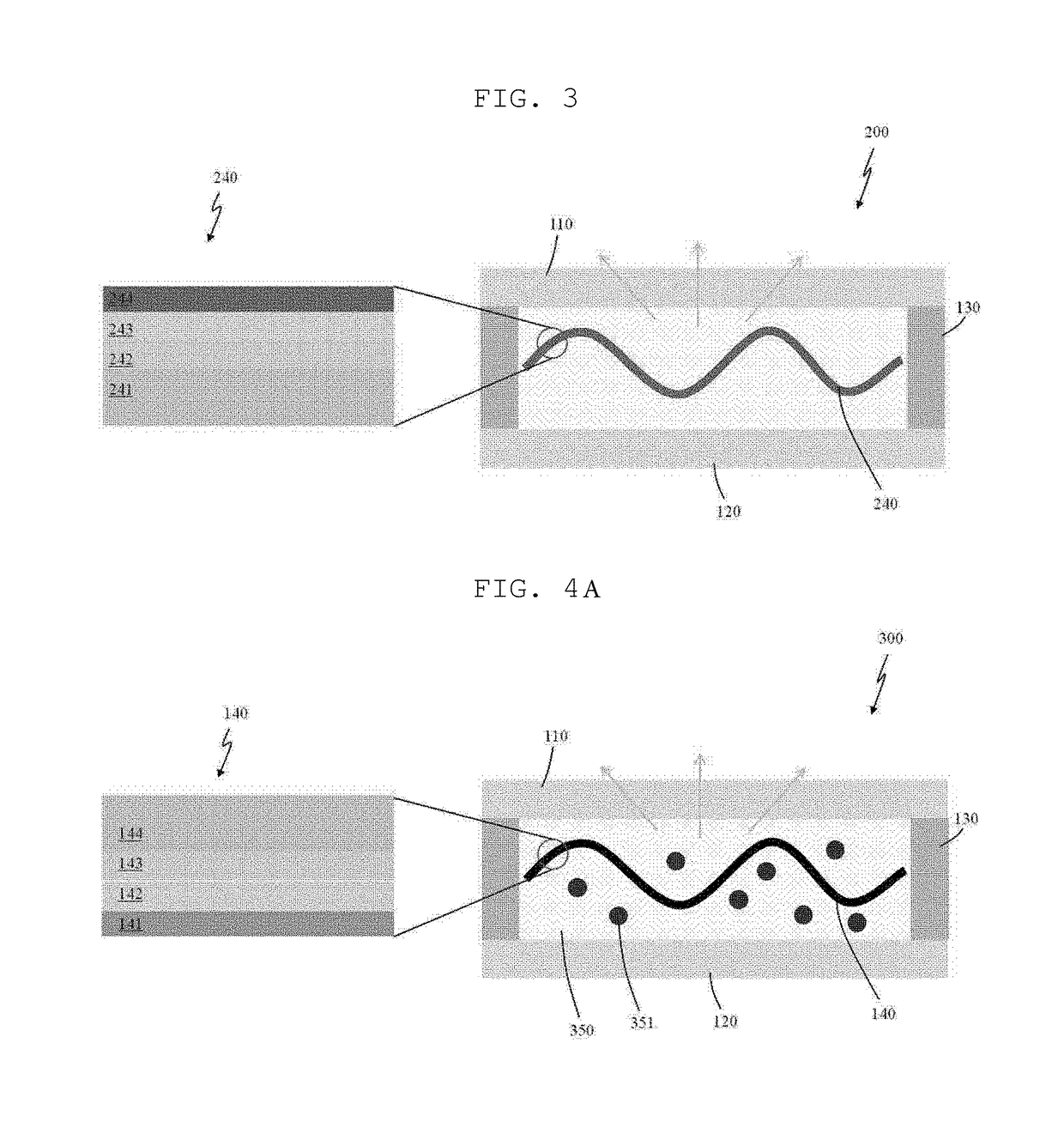Organic light-emitting device for lighting
a light-emitting device and organic technology, applied in the direction of organic semiconductor devices, light-emitting devices for light sources, light-emitting devices for heating apparatus, etc., can solve the problems of reducing the overall luminous efficiency of the oled, limiting the distance that light can travel forward, and lowering the light extraction efficiency. , to achieve the effect of increasing the light-emitting area, improving luminance, and increasing luminance efficiency
- Summary
- Abstract
- Description
- Claims
- Application Information
AI Technical Summary
Benefits of technology
Problems solved by technology
Method used
Image
Examples
first embodiment
[0040]As illustrated in FIG. 1, an organic light-emitting device for lighting 100 includes a first substrate 110, a second substrate 120, a frame 130, and a flexible organic light-emitting diode (OLED) 140.
[0041]The first and second substrates 110 and 120 are disposed to face each other. In the first embodiment, light generated by the flexible OLED 140 is emitted outwards through the first substrate 110. In this regard, the first substrate 110 may be formed from a transparent plastic material or transparent glass. Here, the second substrate 120 may be formed from the same material as the first substrate 110.
[0042]The frame 130 is dispose between the first substrate 110 and the second substrate 120 that face each other. The frame 130 is formed along the peripheries of the first substrate 110 and the second substrate 120 to define a space between the first substrate 110 and the second substrate 120, i.e. a space in which the flexible OLED 140 is disposed, while hermetically sealing t...
second embodiment
[0050]Hereinafter, reference will be made to an organic light-emitting device for lighting in conjunction with FIG. 3.
[0051]FIG. 3 is a cross-sectional view schematically illustrating the organic light-emitting device for lighting according to the second embodiment.
[0052]As illustrated in FIG. 3, the organic light-emitting device for lighting 200 according to the second embodiment includes a first substrate 110, a second substrate 120, a frame 130, and a flexible OLED 240.
[0053]The components of the second embodiment are substantially identical to those of the first embodiment except for the structure of the flexible OLED. The same reference numerals will be used to designate the same components, and descriptions thereof will be omitted.
[0054]The flexible OLED 240 according to the second embodiment is a transparent OLED having a double-sided light-emitting structure. In this regard, the flexible OLED 240 according to the second embodiment includes a flexible base 241 and a first tr...
third embodiment
[0056]Hereinafter, reference will be made to an organic light-emitting device for lighting in conjunction with FIG. 4.
[0057]FIG. 4 is a cross-sectional view schematically illustrating the organic light-emitting device for lighting according to the third embodiment.
[0058]As illustrated in FIG. 4, the organic light-emitting device for lighting 300 according to the third embodiment includes a first substrate 110, a second substrate 120, a frame 130, a flexible OLED 140, and a filler layer 350.
[0059]The third embodiment is substantially identical to the first embodiment except for the filler layer being disposed in the space. The same reference numerals will be used to designate the same components, and descriptions thereof will be omitted.
[0060]The filler layer 350 is formed by filling the interior of the space defined by the first substrate 110, the second substrate 120, and the frame 130 with a resin material, such as PMA. The filler layer 350 serves to fix the flexible OLED 140, i....
PUM
 Login to View More
Login to View More Abstract
Description
Claims
Application Information
 Login to View More
Login to View More - R&D
- Intellectual Property
- Life Sciences
- Materials
- Tech Scout
- Unparalleled Data Quality
- Higher Quality Content
- 60% Fewer Hallucinations
Browse by: Latest US Patents, China's latest patents, Technical Efficacy Thesaurus, Application Domain, Technology Topic, Popular Technical Reports.
© 2025 PatSnap. All rights reserved.Legal|Privacy policy|Modern Slavery Act Transparency Statement|Sitemap|About US| Contact US: help@patsnap.com



